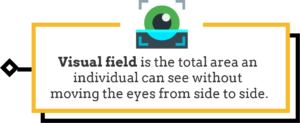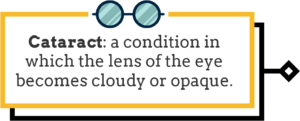Blindness Is Not All or Nothing
Updated: April 16, 2021
When people hear the word blind, they often think of someone who cannot see at all. However, blindness isn’t black and white – there is a huge grey area.
3.5% of the world’s population live with vision impairment – that’s 253 million people. Of these people, 36 million are totally blind and 217 have moderate to severe vision impairment. What does that mean, and how can we make web and video content more accessible to these people?
Understanding the Definitions
Total blindness refers to the complete lack of light perception and form perception. Although people use the term “blind” colloquially, often this is incorrect. According to the American Foundation for the Blind (AFB), “85% of all individuals with eye disorders have some remaining sight; approximately 15% are totally blind.”
Legal blindness is a term used by the United States government to determine eligibility for various services and programs – including vocational training, rehabilitation, schooling, benefits, devices, and tax exemption programs. This term doesn’t actually describe what a person can and cannot see.
“A majority of the blind community are people with low vision. We can still see a little, or most of the detail of what we’re looking at, it just depends on environmental conditions. I am visually impaired, but I am also a painter, and I coach soccer.”
– JD Dalton, Faces Behind the Screen
How do you measure a person’s vision?
There are two measurements that are used to evaluate a person’s vision: visual acuity and visual field.
Visual acuity is a number that indicates the sharpness or clarity of vision. In the US, the Snellen Eye Chart is used to measure distance visual acuity. This is the test where your eye doctor asks you to read rows of letters, numbers, or symbols from a fixed distance (usually 20 feet). A visual acuity measurement of 20/70 means that a person with 20/70 vision who is 20 feet from an eye chart sees what a person with perfect (20/20) vision can see from 70 feet away.

Note: Both visual acuity and visual field are determined with the best possible correction (i.e. contacts or glasses) in the better seeing eye.
Types of Vision Impairments
There are many different types of visual impairments that cause low vision, or partial vision loss. Often people think that someone who is vision impaired can’t see at all, but it’s not this black and white. Just like individuals who are hard of hearing, there are many causes and types of vision impairments that cause partial loss of vision. The leading causes of blindness and low vision in US adults are attributed to four age-related eye diseases: cataracts, diabetic retinopathy, glaucoma, and age-related macular degeneration.
Cataracts
Cataracts, a condition in which the lens of the eye becomes cloudy, causes images to appear blurred or fuzzy. Typically, cataracts form slowly over time, and can affect one or both eyes. Most cataracts are related to aging, and affect more than 50 percent of all adults by age 80. In the US, cataracts are the primary cause of vision loss in people 55 and older.
Diabetic Retinopathy
According to the Centers for Disease Control and Prevention (CDC), more than 100 million US adults are living with diabetes or prediabetes. Diabetic retinopathy is an eye condition occurring as a result of changes in the tiny blood vessels of the retina. This is a leading cause of vision loss in US adults.

Image from AFB: Normal vision (left) and advanced vision loss from retinopathy (right)
Glaucoma
Glaucoma is a disease in which the pressure of the fluid inside the eye is too high, resulting in a loss of peripheral vision. Glaucoma often progresses with no symptoms or warning signs, making early detection crucial. If the condition is not diagnosed and treated, the increased pressure can damage the optic nerve, eventually leading to total blindness.

Image from AFB: Normal vision (left) and moderate vision loss from glaucoma (right)
Macular Degeneration
Macular degeneration is a disease that causes dysfunction of the macula, the area in the middle of the retina responsible for central vision – think the vision you use for reading, driving, and recognizing faces and colors. The condition is commonly known as age-related macular degeneration, and is the leading cause of visual impairment among older people. There are also other types of macular degeneration which are not age-related, including Stargardt’s Disease.
See For Yourself
There are many causes and types of vision loss. The best way to get an idea of what it might be like to have low vision is to try a simulation. That’s why you will find us at conferences and events with our vision simulation goggles. These goggles simulate a number of different eye disorders, including many of the ones mentioned above. Two visitors to our booth at a recent conference were very surprised when they tried on goggles that simulated a cataract (left) and tunnel vision (right).
Making Content Accessible for the Blind and Low Vision
71% of people with disabilities leave a website immediately if it is not accessible.
With the amount of digital technology, videos, and online content increasing exponentially, it is crucial to make this content accessible for everyone. Understanding different types of vision loss as well as the shear number of people affected by low vision in the US helps to understand the need for accessible content for these consumers. These individuals make up a large percentage of the population, and growing, as the population continues to age.
Audio description is a track that narrates the important visual information in content to help blind or low vision viewers gain as complete of an experience as possible. Many of the same US accessibility laws that require captions for the d/Deaf and hard of hearing also require audio description. Making your video content accessible simply makes it better content!
Learn more about audio description or get started below.












